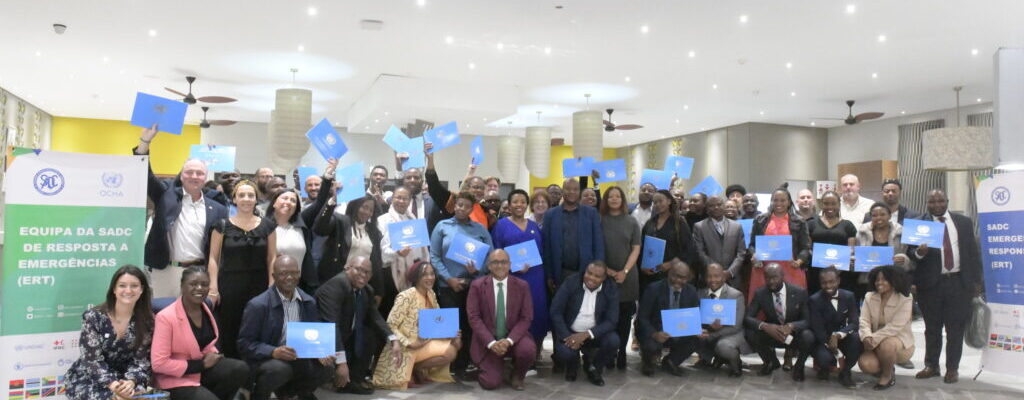SADC ERT Induction in Maun, Botswana (7-19 July 2024)
Southern Africa Development Community (SADC) Emergency Response Team (ERT) is provided for within the SADC Disaster Preparedness and Response Strategy and Fund as a regional rapid response team deployable in major sudden and slow on-set disasters. The SADC ERT is a component of the SADC Humanitarian and Emergency Operations Centre (SHOC) which is hosted in Nacala (Mozambique). The capacity building for SADC ERT by OCHA was requested by the SADC Secretariate DRR Unit in 2021 through OCHA ROSEA with a plan to establish the SADC ERT based on the UN Disaster Assessment and Coordination (UNDAC) system.
OCHA support was linked to the SADC Disaster Risk Management Strengthening in the Southern African Development Community (DRMSS) project funded by the European Union. The overall objective of the DRMSS Project is to contribute to the reduction of the impacts of natural and manmade hazards, strengthen disaster (risk) management, and regional capacity for preparedness and response, and contribute to increased resilience.
The project’s Specific Objectives are as follows:
- Strengthen the coordination and entrenchment of disaster risk management, as well as, capacity for disaster risk reduction (DRR) in development and sectoral policies at both regional and Member States levels;
- Strengthen coordinated regional disaster risk assessments, early warning support mechanisms and integration of national early warning systems (EWSs), as well as disaster preparedness and response;
- Enhance regional disaster risk innovation and information management;
- Effectively manage the DRMSS Project.
OCHA DRMSS COMPONENT
OCHA in line with the SADC DRR Unit request and the DRMSS project is leading on the following components
a. The development of an integrated alert and deployment system for the SADC ERT and training Secretariat and Member States to use this for alerting members of the SADC ERT and deployment-related process
b. Developing a curriculum for SADC ERT based on experiences from the UNDAC methodology
c. Conduct 2 SADC ERT Induction trainings; and
d. Conducting a regional simulation exercise to test SADC ERT, SHOC, and other tools
The Inaugural 2024 SADC ERT Induction
The induction course took place from 7th July to 19th July 2024 in Maun, Botswana. A total of 32 candidates from 12 SADC Member States were trained. The Induction facilitation was led by the OCHA ERS Africa team in collaboration with OCHA ROSEA and the UNDAC global team which is part of the OCHA Emergency Response Section (ERS). This team was supported by IFRC and SADC experts with relevant experiences in UNDAC and/or other global rapid emergency response teams covering different thematic areas. Selected UNDAC partners such as MAPACTION, United Nations University – Institute for Environment and Human Security (UNU-EHS) and UN agencies such as WFP, UNFPA and UNICEF among others also supported the course delivery.
The induction was jointly hosted by the UN Resident Coordinator’s Office in Botswana, OCHA, the SADC Secretariat, and the Government of Botswana. The UNRCO Botswana team supported liaison with the Botswana government and UN Teams in Botswana. OCHA provided technical leadership in induction course design and delivery. SADC DRR unit provided induction co-facilitation and liaison functions with SADC Member States. IFRC provided financial, logistical, and administrative support for the induction based on EU funded DRMSS project. The government of Botswana through the Office of the President and the Ministry of Foreign Affairs were the official hosts of the SADC ERT training and also co-financed some aspects of the financial and logistical elements of the training. UNFPA will also provide some level of co-financing.
Aim of the SADC ERT Induction training
To familiarize SADC ERT members with relevant emergency preparedness and response methodology and prepare them for rapid deployment to sudden-onset emergencies on behalf of SADC to her members states, to assist the national authorities of disaster-stricken respective members states with coordination of the regional humanitarian response.
SADC ERT Induction Training Objectives
Based on prior experiences in conducting induction courses, UNOCHA focused on the following activities in support of the implementation of the SADC ERT Induction training:
- Applying selected aspects of UNDAC methodology as adapted to achieve SADC ERT mission objectives.
- Exercising a key role in response coordination, including coordinated assessments and information management, and ensuring linkages across the national, regional, and international response.
- Promoting inclusiveness in coordination processes and facilitating communication and information sharing to build common situational awareness.
- Assisting SADC ERT members in upholding humanitarian principles and advocating for those most in need.
- Training SADC ERT on the establishment and effective performance of the key functions within an Emergency Operations Centre (EOC/On-Site Operations Coordination Centre (OSOCC).
- Train SADC ERT, SHOC Secretariat and SADC Member States on disaster preparedness and response mechanisms through the SADC ERT deployment mechanism including a disaster simulation exercise (SIMEX).
SADC ERT modelled around the Pillars of the UNDAC System
Methodology: Standard methodology in coordination, needs assessment, information management, the UNDAC Handbook (SADC planning to develop a handbook in the next 3 years).
Roster of experts: The UNDAC system has around 500 professionals in emergency management and disasters active on the roster, SADC targets to build a total of 80 in two years
Deployment Procedures: Just as UNDAC SADC ERT will have 24/7 – mobilization in 12-48 hours and deployment at no costs incurred to the affected country
Next Steps for OCHA and SADC ERT Relationship
Continued capacity development for SADC ERT and other SADC disaster preparedness and response mechanisms as part of wider OCHA/SADC collaboration including the next SADC ERT Induction training next year.
Enhanced interoperability between OCHA and SADC ERT response coordination systems hence easy collaboration with ROSEA surge staff during deployment in regional disaster contexts
Future potential joint deployments (OCHA ROSEA and international surge mechanisms such as UNDAC) within SADC countries in the event of a large-scale response. SADC ERT members will be the same OSOCC as OCHA teams

